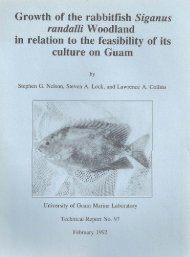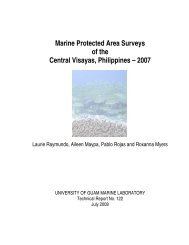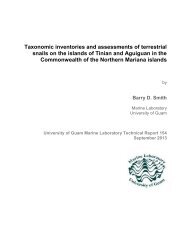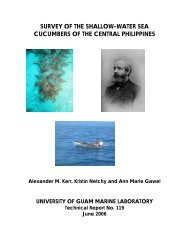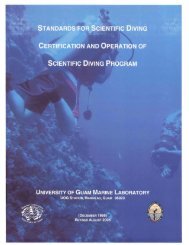MARINE BIOLOGICAL SURVEY OF THE PROPOSED DOCK SITE ...
MARINE BIOLOGICAL SURVEY OF THE PROPOSED DOCK SITE ...
MARINE BIOLOGICAL SURVEY OF THE PROPOSED DOCK SITE ...
You also want an ePaper? Increase the reach of your titles
YUMPU automatically turns print PDFs into web optimized ePapers that Google loves.
14To get some kind of idea what the study site was possibly like beforebeing disturbed a qualitative snorkeling observation was conductedon the opposite lagoon slope and reef-flat platform directly acrossthe channel (Fig. 3) which revealed a coral fauna composed of 44species. If scuba observations were made on deeper parts of thela~oon slope the difference in species composition would probablybe even greater.Macro-invertebrates - The prevalent macro-invertebrates on thereef flat wpre 1aree dpposit-fepding hnlothurians. Although severalspecies of holothurians could be found in each zone (Table 4), eachzone was characterized by different species which were particularlycommon and representative of that zone. The Enhalus-Thalassia Zonewas characterized by clumps of Actinophyga echinites. The Coral andSand Zone was generally characterized by Holothuria eduli~, although~. flavomaculat~ was very common at the seaward edge of the Reef Marginwhich we have included in the Coral and Sand Zone (Table 4). Holothuria!lavomaculata characterized the Reef Slope.Holothuria ~. ~. leucospilota and Stichopus chloronotus werewidespread across the reef flat, but were never common. Holothuriaatra was found out on open sandy areas. Holothuria leucospilota wasunder coral heads and would extend the anterior part of its body outfrom under the coral heads, especially when dusk approached in thelate afternoon. Stichopus chloronotus was found both on sand andcrawling up on head coral formations.Four species in the genus Holothuria were present and showed adistinct pattern of zonation (Table 5). Holothuria atra was mostfrequent at the shoreward edge of the Enhalus-Thalassia Zone.Holothuria edulis was most common at the seaward edge of the EnhalusThalassia Zone and in the Coral and Sand Zone . Holothuria leucospilotawas most common under coral heads on the inner Reef Margin while H.flavomaculata was common under coral heads on the outer Reef Narginand on down the Reef Slope.It is interesting to note that there was no significant differencebetween zones in terms of total abundance of holothurians taken as agroup. Throught the subtidal area of the study site, the mean andstandard error of the mean number of holothurians per 10 m 2 quadrat(n = 72) was 4.6 ± 1.0, or about one holothurian every 2 m2 . Despitethe relative uniformity in abundances, there were six species presentin the Enhalus-Thalassia Zone and seven species present in the Coraland Sand Zone but only two on the Reef Slope (Table 4). Ninety-fivepercent of the holothurians on the Reef Slope were of the one species,H. flavomaculata.Synaptid holothurians were also present in the study area, butthey are generally nocturnal and so they were not sampled.





